The child at 7 months became more independent and active. He is constantly engaged in “research” activities, requires the attention of adults, as well as ensuring his complete safety. Development and intensive growth require additional nutrients, which the old feeding standards no longer provide. What should be the menu for a 7-month-old baby and how should it fit in with his or her lifestyle?
Psychomotor development
Every day the baby pleases and surprises his parents with the development of new skills. Not so long ago he just started sitting, and at 7 months he can already step with his legs on his own, rise from a support, squat and sit on his knees. Interest in the world around him arises in the desire to get acquainted with various objects that appear in his field of vision. The baby grasps large toys well and confidently transfers them from hand to hand.
The child is now starting to crawl, and does it equally well backwards and forwards. This method of movement opens up new horizons for the baby: it becomes possible to independently pick up any object of interest, as well as get to know the space better. Interest in the surroundings is not limited to contemplation, and at the first opportunity, the little researcher will definitely try everything that is in the access zone. The baby is happy to find familiar objects at the request of adults and turns towards the speaker when he hears his own name. At this age, attachment to family is especially evident. The child recognizes loved ones with whom he is happy to meet after a long sleep. There is wariness towards strangers.
Waking time is accompanied by constant babbling - regularly repeated syllables that are mistakenly perceived by adults as conscious speech. At the same time, the baby's babble is the initial attempts to communicate, imitation of adults, as well as the expression of an emotional state. The baby turns from a listener into an interlocutor who willingly repeats intonation and syllables.
Features of feeding
The baby’s ability to sit and confidently hold objects in his hand allows you to organize a new way of consuming food and the child’s menu at 7 months:
- feed from a spoon, and to gain skills in using the device, give the baby a spoon;
- Feeding the baby should be done exclusively in a sitting position, and it is advisable if he takes a place in a special chair at the common table;
- allow you to get acquainted with what is contained on the plate in a sloppy, yet “manual”, very educational way;
- drink from a cup and invite the baby to drink from a sippy cup or sippy cup on his own;
- set your own example of behavior at a common table, which will form the rules for eating in the future.

Feeding regimen for a breastfeeding child
Mothers who have enough breast milk are usually in no hurry to switch their baby to “adult food”. Until the baby begins to show interest in other foods, he may not need additional nutrition. In this case, complementary foods are calmly introduced after 7-8 months.

But if the child is actively interested in what mom and dad eat, it is important to create a complete menu for the child at 7 months. At this stage, the baby will continue to receive nutritious mother's milk, but will already begin to get acquainted with other dishes.
Below we will consider exactly how to breastfeed a baby at this age, and what dishes to choose for complementary feeding.
Features of breastfeeding at seven months of age
By the second half of the year, the baby is psychologically and physiologically ready to accept complementary foods, but his reaction to such lunches and dinners still needs to be carefully monitored. After six months, breast milk should remain the basis of a child’s nutrition. But the reception schedule changes somewhat.
Almost always by this age a certain feeding regimen for the child has been developed. Everything is individual here - some children need 6 or more daytime and up to 3 nighttime meals, others only need 6 per day, and the rest of the time they are satisfied with complementary foods.
The wishes of the baby at this age should be respected. If his behavior shows that he prefers breast milk to complementary foods, do not rush to switch him to “adult” food.
Breastfeeding is not limited in volume - the baby must stop himself when he feels full. If he turns away from complementary feeding, offer the breast, and next time try again, but do not put pressure on the baby.
Key points:
- breastfeeding on demand;
- the baby himself determines when he is full of milk;
- Complementary feeding is introduced when the child is clearly interested;
- If you refuse complementary feeding, we continue to feed you milk.
If the baby actively shows interest in complementary feeding, do not deny him this. Breast milk will be the best food for the first breakfast and the last meal of the day, and complementary foods will support your strength throughout the day. Below we will look at what and how to feed your baby if he is ready for complementary feeding.
Feeding: when, how much and what?
So, what to feed a 7 month old baby? The feeding regimen for babies of this age includes five meals a day. The main feature is the formation of meals corresponding to full future breakfasts, lunches and dinners. Day after day, new products replace mother's milk, which is now given exclusively before bedtime and in the morning.
Between feedings, intervals of 4 hours correspond to the physiological capabilities of the child’s body, without causing discomfort from the gastrointestinal tract. There are certain norms for food consumption. At the same time, the amount of food eaten depends largely on the characteristics of the baby:
- speed of metabolic processes;
- constitutions;
- physical activity.
Let's figure out what to feed a baby at 7 months. An approximate diet for a baby is presented:
- Vegetable puree.
- Baby formula or milk.
- Egg yolk.
- Porridge (vegetable broth or milk).
- Meat puree.
- Cottage cheese.
- Kefir.
- Canned or freshly prepared fruit puree (a child at 7 months can also be given juices).
- Bread.
- Crackers (dryer or cookies).
So, what should you give your baby at 7 months? There is a traditional order of introducing complementary foods: vegetable purees and cereals are offered at 6 months during breastfeeding, earlier during artificial feeding, after 2 weeks alternately - yolk, kefir, butter, meat, after 8 months - cottage cheese.
Sleep and night feedings
A baby's sleep schedule at this age can include up to 14-15 hours of rest, of which the child sleeps 6-11 hours at night. Some children sleep through the night, occasionally waking up before dawn. During the day, sleep lasts up to 4 hours - divide this time into 2 quiet hours during the day.
Approximate schedule:
- daytime sleep – 3.5-4 hours;
- night sleep – 11 hours;
- total – 14.5-15 hours.
At this age, you can already teach your baby to calm down on his own and fall asleep at night if he suddenly wakes up.
At 7 months, a baby is already interested in adult food, wants to move more, and also knows what exactly needs to be done to attract his mother’s attention. Let him create a daily routine with you - keep track of what food he likes, when he is sleepy, and when he is ready to play. This way you will create a comfortable schedule in which the baby will fully develop, and the mother will always find time for herself and household chores.
Breastfeeding diet
Introducing complementary feeding to a child at 7 months fulfills two main tasks - it compensates for the lack of mother's milk, and also prepares the baby for eating adult food. There is an opinion that with normal lactation in the mother, the time for introducing complementary foods can be postponed until later. Although there is a second point of view, which is aimed in favor of introducing complementary foods:
- helps to master chewing skills in a timely manner;
- acquaintance with various new products stimulates the motor and enzymatic functions of the digestive system;
- provides the baby with additional sources of energy, minerals and vitamins, building material, compensating for the costs of increasing physical activity, development and growth.

Now let's see what explains the presence of various dishes on the baby's menu.
What kind of cereals can a 7 month old baby eat?
Preference is given to rice, buckwheat, and corn cereals, since they are low-allergenic, do not contain gluten, are easily digestible, and also supply the growing body with slow carbohydrates and B vitamins. Slowly digested and absorbed, they maintain a long-term feeling of satiety.
In this case, the “first” porridge for a child should be one-component and liquid. Only after its successful introduction into complementary foods should some other ingredients be added. This way, it will be easier to identify which product the baby will have an allergic reaction to. In this case, you can prepare porridge yourself or use ready-made offers.
For preparation, they use this method: grind the cereal before cooking or grind the already prepared porridge with a blender. It is diluted to the required consistency with vegetable broth, formula or breast milk.
You can calculate the volume of ingredients to create porridge by measuring the required amount of cereal with a spoon:
- To make the porridge 5% liquid, take 1 small spoon of cereal per half a glass of water.
- After a couple of weeks, you can switch to 10%, adding 1.5 tsp to the same volume of water. cereals
- A new dish for a baby is introduced from a small spoon. Portions, if well tolerated, increase every day, reaching 150 g by the end of the 2nd week and completely displacing breast milk from one feeding. The ideal time to eat is 10 a.m. for second breakfast.
Chair
Being on breastfeeding all this time, the mother can already determine by the baby’s stool when something is wrong with the digestive tract. When switching to complementary feeding, the nature of the stool may change. At first, it is important to monitor changes in stool depending on what the child ate in complementary foods.
Based on the sample menu, you can create a diet for your baby that will include both liquid and semi-solid foods. Therefore, stool may be reduced to once a day, and the consistency may change towards a more solid one. Pay attention to the condition of your seven-month-old baby and his diet if the feces have changed and acquired one of these characteristics:
- foamy, too liquid;
- frequent up to 5-10 times a day;
- fetid;
- green, black;
- too hard, causes constipation.
Research what foods trigger this condition. Show your baby to the doctor to rule out intestinal infection and intolerance.
Eggs – only boiled yolk
What else is included in a 7 month old baby's diet? Eggs appear on the baby’s menu only after the introduction of porridge. There is no particular difference in properties between quail and chicken eggs. In their raw form, any of them can cause salmonellosis. Doctors always insist on following the necessary rules for their preparation: wash thoroughly before cooking, check for freshness (the missing ones “stand” vertically in the water or float), cook for at least 10 minutes.
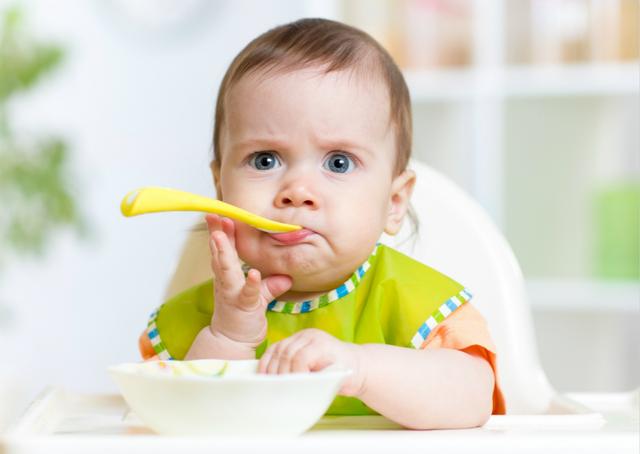
Yolk, like white, can cause allergies. Therefore, it is administered with caution. At the 10 o'clock breakfast, they offer a yolk (1/8), ground with milk, on the tip of a spoon. After 3 days, in the absence of allergies, the yolk is increased to 1/4, gradually increasing to ½ yolk a maximum of twice a week.
This valuable product will provide the growing body with vitamins, phosphorus and selenium. If the baby refuses to eat the offered yolk in its pure form, the product is mixed with vegetable puree or porridge, which can also diversify the diet of a 7-month-old child.
What you need to know about food quantity
First of all, you should understand that every person, no matter how small, is unique not only mentally, but also physically - everyone has a different body, their own history of birth. It follows from this that the amount of food will vary according to personal needs. In order for the baby to develop normally and be healthy, it is enough to consult with pediatricians and monitor him.
In general, nutritional standards are very relative, according to Dr. Komarovsky. And the child, in theory, does not owe anything to anyone, because all children are unique and live in unique conditions. So the concept of “amount of food” needs to be formed by ourselves, in consultation with a pediatrician and without focusing on various institutions.
Olga Mayorova, assistant at the Department of Childhood Diseases in St. Petersburg, believes that the amount of food for 7-8 month old children should be quite large - about 1100 ml per day, since the body grows, as do its needs.
Kefir and cottage cheese
A child's diet at 7 months also includes cottage cheese and kefir. The introduction of kefir requires the same rules as any other new product - starting in small quantities. After introducing your child to it, you can easily introduce cottage cheese into your diet. A teaspoon of it is diluted to a homogeneous consistency with kefir, increasing the volume by 2 times daily. In order to track the emerging reaction to a new product, it is offered to the baby for the 2nd breakfast. With normal tolerance, the intake of kefir and cottage cheese is transferred to the 2nd half of the day (afternoon snack), when these products are absorbed best.
To feed a 7-month-old baby, it is unacceptable to buy market cottage cheese, as well as “adult” store-bought kefir. The safest and healthiest products are those from special children's departments, as well as those purchased at the dairy kitchen. At the same time, when purchasing, you should always be interested in the composition and date of manufacture. Fermented milk products can be given to a child every day, while observing age norms. In the baby’s diet, by the end of the seventh month of life, cottage cheese is 30 g, while kefir is about 170 ml.
It is necessary to temporarily give up kefir when unstable stools appear, and from cottage cheese when the fontanel is rapidly overgrowing, as well as in the presence of kidney disease.
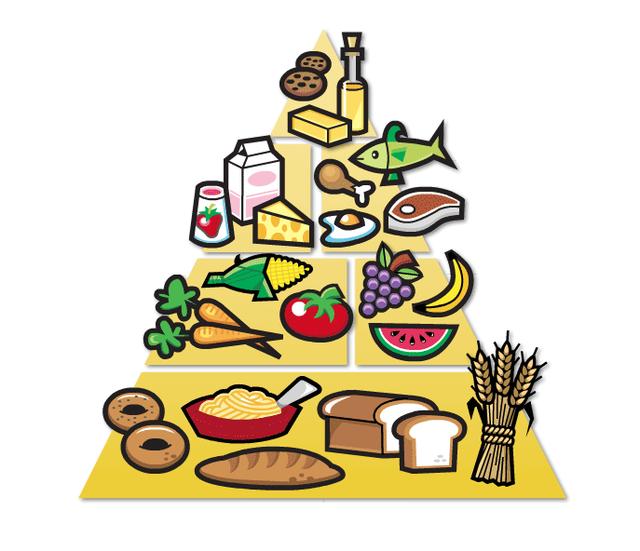
New complementary feeding products
So, the baby is actively interested in what mom and dad eat at the table, but still continues to eat breast milk. A child’s diet at 7 months can be varied with the following dishes:
- Porridge. Complementary feeding starts with them (or vegetable puree), as they are well absorbed and children like the taste. Choose buckwheat, corn porridge, rice porridge. Oat porridge with a liquid consistency will be available a little later.
- Meat. If the child does not have allergies and digestion is normal, dietary meat can be introduced into the diet: turkey, rabbit, chicken. Prepare as a puree or soufflé with water or breast milk. It is not advisable to use broth.
- Yolk. Chicken yolk is rich in polyunsaturated fats and vitamins. But it can cause allergies, so first you should give a quarter of the yolk a day two to three times a week, diluting it with meat or vegetable puree.
- Vegetables. Rich in fiber, they are beneficial for the functioning of the stomach and intestines. You can include pumpkin, potatoes, carrots, and beans in your baby’s diet.
- Fruits. Apples and bananas become favorite treats during complementary feeding, as well as apricot and pear puree, which are sweet in taste and healthy for the child’s body.
- Kefir and cottage cheese. It is better if these are homemade products; the first portion should be no more than 20 grams, so as not to overload the baby’s gastrointestinal tract. The volume of these products is gradually increasing.
A breastfed baby of 7 months will willingly try fruit purees, fermented milk products and cereals. How much a child at seven months should eat one or another type of complementary food is an individual parameter. It is better to administer slowly so as not to overload the baby’s gastrointestinal tract. Input standards are conditional and must be individually adjusted.
Table of daily norms and recommendations
| Name of the dish | General norm per day | Recommendations |
| Oatmeal, buckwheat, rice, corn porridge | 150 g | Do not use cow's milk for cooking |
| Pumpkin, carrot, cabbage, zucchini puree | 170 g | You can add beans |
| Banana, pear, apple puree | 70 g | Avoid strawberries and citrus fruits |
| Dairy products | 50-100 g | Only children's kefir, homemade cottage cheese |
| Boiled chicken egg yolk | 0.25 g | Don't use protein |
| Compotes, juices from carrots, apples, peach, apricot | 70 ml | Dilute with water in a ratio of 1:1 |
| Crackers, croutons, cookies | No more than 30 g | Soak in breast milk or water |
Remember that daily norms are a relative value. Also, you should not give preference to only one type of complementary food. Try to make your baby's menu varied.
Sample menu
We offer an example menu for a 7-month-old baby. You can use it as a basis for creating an individual diet for your baby.
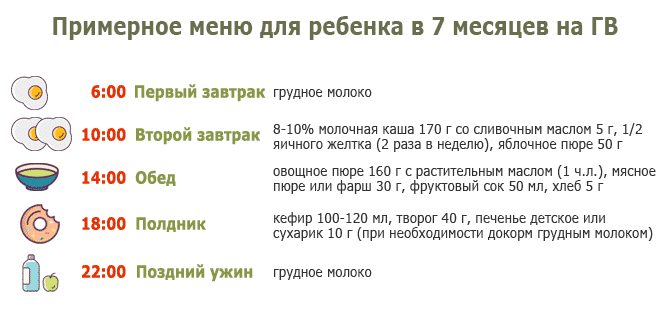
The first and last meal of the day is mother's milk. Other dishes and drinks are offered in the table.
| Day/Meal | Lunch | Dinner | Afternoon snack |
| Monday | Semolina porridge – 150 g, cottage cheese with peach puree – 50 g, pear puree – 50 g | Cabbage puree with pumpkin – 180 g, turkey soufflé – 70 g, ¼ yolk | Homemade yogurt – 80 g, buckwheat porridge – 100 g, children’s cookies – 7 g |
| Tuesday | Buckwheat with pumpkin – 100 g, plum puree – 50 g, baby cottage cheese – 50 g | Meatball soup with carrots and herbs – 200 g, pear puree – 50 g | Corn porridge with pear – 150 g, croutons |
| Wednesday | Rice pudding – 100 g, jelly – 50 g, cottage cheese soufflé – 50 g | Rabbit meat and broccoli puree – 200 g, peach soufflé – 50 g, fruit juice – 80 g | Children's kefir – 100 ml, oatmeal – 100 g, baked apple puree |
| Thursday | Corn porridge with berries – 100 g, children’s cottage cheese – 50 g | Pumpkin soup – 200 g, fish cutlets – 50 g, fruit juice – 50 g | Homemade yogurt – 100 ml, rice porridge with apple and pear – 100 g |
| Friday | Rice porridge with pear, children's cottage cheese – 50 g | Chicken soup – 150 g, pear puree – 50 g, berry juice – 100 g | Kefir – 150 ml, oatmeal – 100 g, pear puree – 50 g |
| Saturday | Buckwheat porridge with pumpkin – 100 g, fruit jelly | Zucchini puree with turkey meat – 200 g, baked apple | Barley porridge – 100 g, homemade yogurt – 100 g, children’s cookies – 5 g |
| Sunday | Barley porridge with peach – 100 g, children’s cottage cheese – 50 g | Vegetable soup – 150 g, fish puree – 50 g, fruit soufflé – 70 g | Yogurt with chopped pear – 150 g, buckwheat – 100 g |
A varied menu is a guarantee that the baby will receive a sufficient amount of proteins, fats, carbohydrates, vitamins and minerals every day. The menu should meet the baby’s energy needs for the day.
Artificial baby diet
It should be understood that artificial feeding does not meet all the needs of a small body, like breastfeeding. Even adapted high-quality formulas cannot provide the baby with the required amount of essential nutritional elements. Consequently, feeding a 7-month-old child on artificial feeding involves the introduction of complementary foods a month earlier than for babies on natural feeding.
Products unfamiliar to babies have long been included in the diet of artificially-trained children - pureed meat, porridge, egg yolk. According to indications, liver, meat, kefir and cottage cheese can be introduced into the menu earlier.
How to understand how much meat your baby needs?
Meat is a very delicate product, especially for a child 7-8 months old, so you need to seriously consider the question of how much such food he can eat. In general, at first you should give less meat - a quarter or half a teaspoon - in order to gradually accustom it to the taste and density of the product. Usually doctors advise giving lean beef, but some children are allergic to cow's milk, and in this case they should not be given beef either.
Another type of meat that is recommended to start complementary feeding is rabbit meat, since rabbit meat is very tender. If your child starts getting acquainted with meat from rabbit, then you can try giving it half a teaspoon at once. If no allergies or problems with bowel movements occur after it, you can increase the amount of meat by 5-6 times in 6-7 days.
Purees and meat broths
From the age of 7 months, meat appears on the baby’s menu in the form of veal puree, lean beef, chicken fillet, turkey, and rabbit. It is worth noting that the range of food departments for children is ready to offer a huge selection of products from domestic and foreign manufacturers (Hipp, Heinz, “Babushkino Lukoshko”, Gerber, “Agusha”, “Tema”, Fleaur Alpine, etc.). It is important to look at the age recommendations indicated on each jar.
Trying to diversify a child’s diet at 7 months by introducing meat, you can prepare it at home, which is not at all difficult:
- Cook the meat, chopped into pieces, until cooked.
- Grind thoroughly with a blender.
- Before feeding, dilute the prepared broth to the consistency of a light puree.
- If the child refuses the proposed dish, add it to vegetable puree or porridge.
Meat products take longer to digest than the same vegetable soup for a 7-month-old child, therefore, they are always given lunch time. Light, non-rich broths are used to create vegetable puree soups and porridges. They improve the digestion process, while increasing the activity of the secretory glands.
During this period of time, the bottle-fed baby tries new types of cereals, and also gets acquainted with pureed vegetable soups with meat broth and other multi-component purees. What fruits can a 7 month old child have in this case? Apple, banana, prune, pear - these are the fruits that the baby can already try. Meat puree once a week can replace puree made from liver.
Regardless of the type of feeding, 7-month-old babies should be encouraged to try solid food, of course, if they have already developed teeth. Crackers, dry bread or children's cookies for an afternoon snack are an excellent opportunity to stimulate the chewing process in time. At the same time, a slow transition gradually begins from homogeneous purees to food containing small lumps and pieces. At the same time, a special grater is used to create puree from fresh vegetables and fruits, while boiled vegetables are simply chopped with a fork.
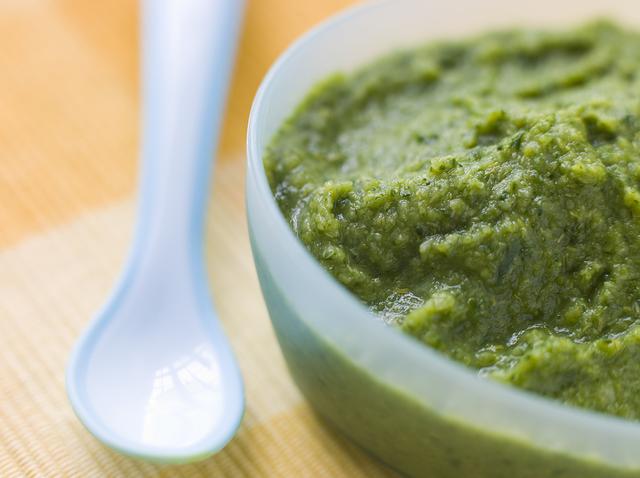
Baby menu at 7 months: what’s possible and what’s not?
When creating a new menu, you need to take into account two feedings with breast milk or formula and three meals of solid food per day. What to feed a child at 7 months, in what quantity and how often to give new complementary foods, so that he eats well and does not react painfully to seemingly ordinary foods, says nutritionist Anastasia Ivanovna Shalunova.
— Anastasia Ivanovna, what are the nutritional features of children at 7 months?
— The menu of a child at seven months differs from the menu of a newborn and a one-year-old child. This difference exists due to the fact that a newborn has not yet developed a number of body systems, including the gastrointestinal tract and oral cavity, he is just learning to suck. From four to six months, the diet begins to include complementary foods - foods that differ from breast milk or infant formula. At one year of age, under ideal conditions, the child is transferred to a common table.
Some pediatricians recommend introducing complementary foods from five to six months, sometimes even from four. But the enzymatic system of the baby’s body has not yet been formed, so pedagogical complementary feeding is possible at four or five months, and pediatric complementary feeding by six months.
— How to properly combine breastfeeding or bottle feeding and complementary feeding?
— Pediatricians and nutritionists recommend separating these meals and giving basic milk nutrition and complementary foods at different feedings so that the child understands what he is eating.
If complementary feeding started at 4-5 months:
Breast-feeding
| Artificial feeding
|
— What rules of baby nutrition should parents know?
— The functions of the gastrointestinal tract are formed in such a way that the body needs to adapt to incoming products. With proper complementary feeding, it is important to monitor the child’s condition using a food diary and, if necessary, consult a doctor.

Basic recommendations for feeding seven-month-old babies
- One new product is given in small doses at the beginning of the day every four days to monitor allergies, constipation, peeling and other reactions.
- You can give one new product per feeding.
- It is better to offer water between feedings and not to give it along with complementary foods.
- You should not force feed: if a child refuses a certain dish, it can be offered at another time and in another form.
- A child should not be given unfamiliar food when he is not in a very good mood, is teething, or has just had a vaccination.
— How to identify food allergies and find the allergen?
- Observant mothers will see or hear the problem. The baby will develop something on his body, constipation or an upset stomach. A restless child will cry. To track the allergen, it is advisable to keep a food diary and keep your finger on the pulse. If you have a connection with a pediatrician, ask questions and, taking into account the vaccination calendar and the physiology of your child’s development, offer him certain products so as not to provoke an immune response again.
What foods can be given at 7 months?
Making up the main diet
| Try it in small quantities
| Excluded from the diet
|
Read about why it is necessary to introduce meat complementary foods into a baby’s diet and what products it can be combined with
- What purees and cereals can be given at 7 months?
— If this is the baby’s first complementary food, then mono-component purees, dairy-free and milk porridges with one grain in the composition are good: they are easier to digest and it is easier to track the body’s reaction.
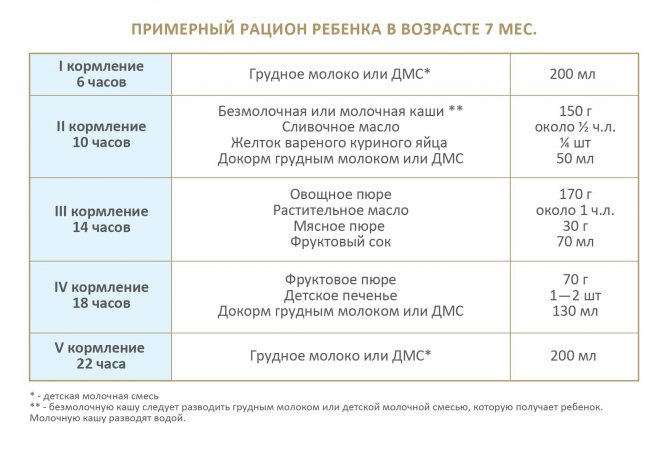
— In what order can complementary foods be given?
- If by seven months the child is overweight, then it is better to feed him vegetable puree. If everything is in order with your weight, then preference can be given to porridge. All new products are introduced gradually: they begin to feed in an amount of 5-10 g, gradually increasing the volume to 50 g. By seven months, a portion of porridge at one time can reach up to 200 g. The third option for complementary feeding, if parents want, can be fruit. It is in this sequence, because fruits are sweet, and the child does not always eat unleavened vegetables or grains after them.
Each product will also have its own specific processing:
- vegetables and fruits are given in the form of puree;
- store-bought porridges are prepared according to instructions;
- homemade porridge is boiled in water, then milk or mixture is added if desired;
- cottage cheese is stored correctly in the refrigerator, tracking the expiration date;
- Dairy and vegetable decoctions are brought to a uniform consistency (puree) so that the child develops the correct perception of the product.
— How many times should I feed a child at 7 months and how much food should I give?
— You need to aim for five feedings a day. If a child cannot maintain the interval between meals, it is worth supplementing him with breastfeeding or formula after introducing complementary foods.
How to calculate the volume of complementary foods
A child at seven months should weigh about eight kilograms. 1/8 of a child’s weight is the daily amount of food, that is, approximately a kilogram of food including all feedings, or 200 grams per meal.
Approximate menu for a 7 month old baby (Russian Federation)
| Breast-feeding | Artificial feeding |
| First breakfast and last feeding must include breast milk or infant formula | |
Breakfast
| Breakfast
|
Dinner
| Dinner
|
Afternoon snack
| Afternoon snack
|
| The interval between feedings is 3.5-4 hours | |
| Breast-feeding | ||
| First breakfast and last feeding must include breast milk or infant formula | ||
Breakfast
| Dinner
| Afternoon snack
|
| The interval between feedings is 3.5-4 hours | ||
| Artificial feeding | ||
| First breakfast and last feeding must include breast milk or infant formula | ||
Breakfast
| Dinner
| Afternoon snack
|
| The interval between feedings is 3.5-4 hours |
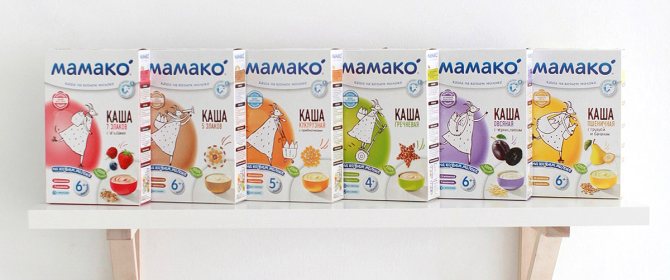
— At what age can semi-solid and solid foods be introduced into a child’s diet?
— By 6 months, most children are ready for new food: the child understands that he has something hard in his mouth. By seven months, the skill of palm grip is formed: the child is able to hold solid food in his hand, and he can be given cookies and crackers to grate. Allergists and pediatricians consider 6-10 months as the optimal period to begin introducing semi-solid and solid foods. But if the swallowing apparatus is not formed, there may be problems with chewing and impaired swallowing, including a gag reflex.
— What should parents do if their child refuses to eat? How to create food interest?
— You need to understand the reasons for your baby’s refusal to eat, which may include:
|
|
You should not introduce new foods during unfavorable periods for the baby, or insist on finishing the food: when he gets hungry, he will eat. The pediatrician will monitor changes in health using tests and, if necessary, adjust nutrition.
At seven months, significant changes occur in the functioning of the gastrointestinal tract; the child actively shows interest in “adult” foods and new tastes. It will be easier for the baby to adapt if you choose products that will match his physiology and fully cover his needs for growth and communication. You need to carefully monitor the body's reaction to each new product for 4-6 days.
Nutritionist Anastasia Ivanovna Shalunova
*The ideal food for an infant is mother's milk. WHO recommends exclusive breastfeeding for the first 6 months. MAMAKO® supports this recommendation. Before introducing new foods into your baby’s diet, consult a specialist.
Rice and apple porridge
Ingredients:
- rice flour – 10 g;
- 40 g apple;
- 70 ml milk;
- 30 ml water;
- butter.
To begin with, the milk is brought to a boil, then the rice, previously ground into flour, is added, stirring all the time. Cook for 5 minutes. The peeled apple should be grated, then mixed with porridge, and then grind in a blender. Add oil at the end.
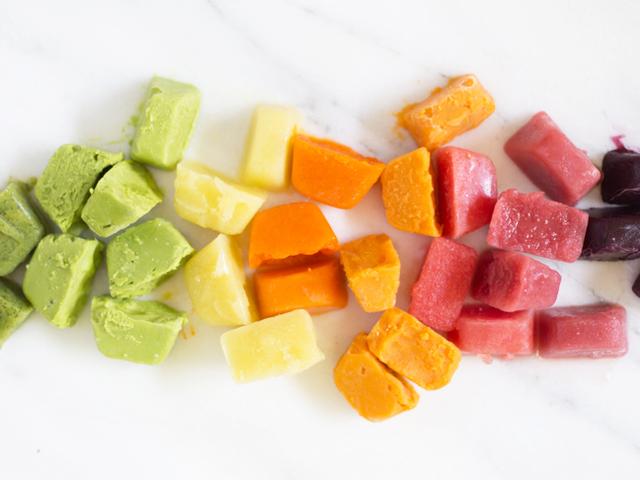
About etiquette
The baby is growing up before our eyes, therefore, a 7-month-old child should be taught proper behavior in the kitchen:
- Let the baby strive to master the art of using a spoon as a method of independently obtaining food. Make a mental note that learning how to handle a spoon is currently more important than order and cleanliness in the kitchen.
- Since the baby is already sitting confidently, buy him a high chair that will meet safety requirements.
- Eating food should be an extremely enjoyable experience. If a child refuses a certain dish, you should not force feed him. In this case, try to find out the reason for the refusal. The food was probably too hot.











